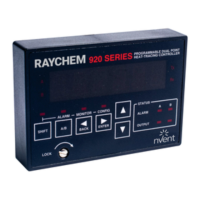29 / 82
EN- Raychem920series-IM-H5687405/15
INDUSTRIAL HEAT TRACING SOLUTIONS
setting EXTERNAL INPUT to NOT USED or TEMPBUS™ will automatically set OVERRIDE
SOURCE to REMOTE.
3.6.4 EXTERNAL OUTPUT PORT
Purpose: The EXTERNAL OUTPUT port can be programmed to allow Point A to function as a
“master” 920 HTC to control up to 25 “slave” 920 HTC units. A “master” can either force its
“slaves” to override their temperature control and force their output switch off (INHIBIT), or it can
send its control temperature to its “slaves” so they can do their own temperature control using
this temperature (TEMPBUS™).
An INHIBIT “master” may be useful when a number of “slave” controllers use their own RTDs,
but are to be turned off based on the ambient temperature. This will allow disabling of the “slave”
controllers during the summer months, during a maintenance shutdown, etc.
A TEMPBUS™ “master” may be useful when a number of “slave” controllers do not have their own
temperature sensors and are set to control the ambient temperature.
Setting: NOT USED, TEMPBUS (V3.11+) or INHIBIT
Procedure: Select NOT USED if Point A is not a “master” controlling the EXTERNAL OUTPUT port.
Select INHIBIT if Point A will be controlling the EXTERNAL OUTPUT port as an INHIBIT “master.”
Select TEMPBUS™ if Point A will be sending its control temperature out the EXTERNAL OUTPUT
port. For TEMPBUS™ operation description see section 5.4 on page 53.
IMPORTANT:
• The“master”and“slave”controllersmustbeinstalledinthesameenclosure.TheEXTERNAL
OUTPUT PORT signal is not intended to be connected over extended distances or between
enclosures.
• IfEXTERNALOUTPUTissettoINHIBIT,thentheDEADBANDparameterforPointAwill
be used to define the operation of the EXTERNAL OUT-PUT port, even though the SWITCH
CONTROL MODE for Point A may not be set for DEADBAND operation. See section 3.5.5 on
page 22 for additional details regarding the DEADBAND mode.
• IftheEXTERNALINPUTPORTinputisnotbeingused,PointBmaybeconfiguredasa“slave”
for a controller with its Point A configured as a “master.”
3.6.5 FLASH ALARM OUTPUT SETTING
Purpose: Programs the alarm output relay for flashing or steady output in case of an alarm
condition.
Setting:YES(Flash)orNO(Steady)
Procedure: Set the alarm output relay to flash or not to flash on an alarm condition, whichever
suits the application.
IMPORTANT:
• Ifthealarmoutputisusedtodriveapilotlight,selectYEStoenableflashingoperation.When
the output is also configured for normally closed operation, the pilot light will be on steady for
normal operation, flash in case of alarm and be extinguished due to a bulb failure or loss of
power.
• Ifmultiplealarmoutputsfromdifferentcontrollersarewiredinseries(i.e.:multipointpanels),
set this parameter to NO (steady).
3.6.6 ALARM OUTPUT NORMAL STATE
Purpose: Configures the alarm output relay for normally open or normally closed operation. The
normal condition is assumed to be when the HTC is powered and no alarms exist.
Setting: N.O. (Normally Open) or N.C. (Normally Closed)
Procedure: Set the alarm output relay to normally open or normally closed to suit the application.
IMPORTANT: If a pilot light is used for indication of alarms, normally closed operation provides a
steady illumination of the lamp when the circuit is operating correctly. A light that is flashing or
out indicates a fault condition. A burned out lamp is readily identified if the HTC is set to flash the
alarm output relay in case of alarm. See the section 3.6.5 on page 31.
3.6.7 LANGUAGE
Purpose: Defines which language the optional 920 Operator Console uses when prompting the

